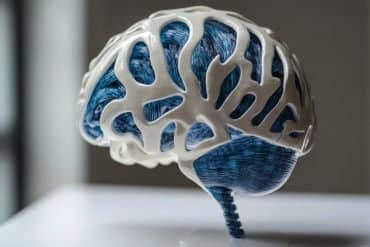Summary: Cannabinol, an active ingredient in cannabis, can help protect brain cells from oxidative damage and preserve mitochondrial function.
Source: Salk Institute
Decades of research on medical cannabis has focused on the compounds THC and CBD in clinical applications. But less is known about the therapeutic properties of cannabinol (CBN). Now, a new study by Salk scientists shows how CBN can protect nerve cells from oxidative damage, a major pathway to cell death.
The findings, published online in the journal Free Radical Biology and Medicine, suggest CBN has the potential for treating age-related neurodegenerative diseases, like Alzheimer’s.
“We’ve found that cannabinol protects neurons from oxidative stress and cell death, two of the major contributors to Alzheimer’s,” says senior author Pamela Maher, a research professor and head of Salk’s Cellular Neurobiology Laboratory. “This discovery could one day lead to the development of new therapeutics for treating this disease and other neurodegenerative disorders, like Parkinson’s disease.”
Derived from the cannabis plant, CBN is molecularly similar to THC, but is not psychoactive. It’s also less heavily regulated by the FDA. Previous research by Maher’s lab found that CBN had neuroprotective properties, but it wasn’t clear how it worked. Now, this new study explains the mechanism through which CBN protects brain cells from damage and death.
Maher’s team looked at the process of oxytosis, also called ferroptosis, which is thought to occur in the aging brain. Growing evidence suggests that oxytosis may be a cause of Alzheimer’s disease. Oxytosis can be triggered by the gradual loss of an antioxidant called glutathione, causing neural cell damage and death via lipid oxidation. In the study, the scientists treated nerve cells with CBN, and then introduced an agent to stimulate oxidative damage.
They further found that the CBN worked by protecting mitochondria, the cell’s powerhouses, within the neurons. In damaged cells, oxidation caused the mitochondria to curl up like donuts—a change that’s also been seen in aging cells taken from the brains of people with Alzheimer’s disease. Treating cells with CBN prevented the mitochondria from curling up and kept them functioning well.
To confirm the interaction between CBN and mitochondria, researchers then replicated the experiment in nerve cells that had the mitochondria removed. In these cells, CBN no longer demonstrated its protective effect.
“We were able to directly show that maintenance of mitochondrial function was specifically required for the protective effects of the compound,” Maher said.

In another key finding, researchers showed that CBN did not activate cannabinoid receptors, which are required for cannabinoids to produce a psychoactive response. Thus, CBN therapeutics would work without causing the individual to become “high.”
“CBN is not a controlled substance like THC, the psychotropic compound in cannabis, and evidence has shown that CBN is safe in animals and humans. And because CBN works independently of cannabinoid receptors, CBN could also work in a wide variety of cells with ample therapeutic potential,” says first author Zhibin Liang, a postdoctoral fellow in the Maher lab.
In addition to Alzheimer’s, the findings have implications for other neurodegenerative diseases, such as Parkinson’s, which is also linked to glutathione loss. “Mitochondrial dysfunction is implicated in changes in various tissues, not just in the brain and aging, so the fact that this compound is able to maintain mitochondrial function suggests it could have more benefits beyond the context of Alzheimer’s disease,” Maher said.
Maher adds that the study shows the need for further research into CBN and other lesser-studied cannabinoids. As a next step, Maher’s team is working to see if they can reproduce their results in a preclinical mouse model.
Other authors on the study are David Soriano-Castell, Devin Kepchia, Antonio Currais and David Schubert from Salk; and Brendan Duggan from the University of California San Diego.
Funding: This work was funded by the National Institutes of Health, the Paul F. Glenn Center for Biology of Aging Research at the Salk Institute, an Innovation Award from the Salk Institute, the Shiley Foundation, the Bundy Foundation and the University of California San Diego.
About this brain aging research news
Author: Salk Communications
Source: Salk Institute
Contact: Salk Communications – Salk Institute
Image: The image is in the public domain
Original Research: Closed access.
“Cannabinol inhibits oxytosis/ferroptosis by directly targeting mitochondria independently of cannabinoid receptors” by Pamela Maher et al. Free Radical Biology and Medicine
Abstract
Cannabinol inhibits oxytosis/ferroptosis by directly targeting mitochondria independently of cannabinoid receptors
The oxytosis/ferroptosis regulated cell death pathway recapitulates many features of mitochondrial dysfunction associated with the aging brain and has emerged as a potential key mediator of neurodegeneration. It has thus been proposed that the oxytosis/ferroptosis pathway can be used to identify novel drug candidates for the treatment of age-associated neurodegenerative diseases that act by preserving mitochondrial function. Previously, we identified cannabinol (CBN) as a potent neuroprotection.
Here, we demonstrate that not only does CBN protect nerve cells from oxytosis/ferroptosis in a manner that is dependent on mitochondria and it does so independently of cannabinoid receptors. Specifically, CBN directly targets mitochondria and preserves key mitochondrial functions including redox regulation, calcium uptake, membrane potential, bioenergetics, biogenesis, and modulation of fusion/fission dynamics that are disrupted following induction of oxytosis/ferroptosis. These protective effects of CBN are at least partly mediated by the promotion of endogenous antioxidant defenses and the activation of AMP-activated protein kinase (AMPK) signaling.
Together, our data highlight the potential of mitochondrially-targeted compounds such as CBN as novel oxytotic/ferroptotic inhibitors to rescue mitochondrial dysfunction as well as opportunities for the discovery and development of future neurotherapeutics.







